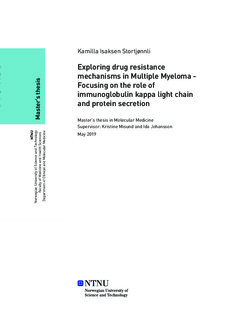| dc.description.abstract | Multiple myeloma (MM) is a type of cancer arising in the bone marrow affecting the immunoglobulin (Ig) producing plasma cells. This causes an uncontrolled proliferation of a single plasma cell clone and an overproduction of monoclonal Igs. MM is considered a rare type of cancer however it is one of the most common haematological malignancies and only about 50% of MM patients will survive 5 years or more. Which isotype of Ig that is produced varies among MM patients, with about 25% producing the IgA isotype and up to 20% of MM patients only producing the light chains of Igs, either as the kappa (IgK) or the lambda isotype. In the last two decades, introduction of novel treatment strategies such as proteasome inhibitors (PIs) have proven to be effective in MM therapy, providing good clinical results and longer survival of MM patients. Despite these advantages, intrinsic and acquired resistance against MM treatment have become a major challenge that eventually cause MM patients to relapse. MM is thus considered as an incurable cancer, and research trying to find new treatment strategies and to identify mechanisms of drug resistance are well under progress but are yet to be found. In this thesis, we first investigated the cytotoxic effects of targeting both the ubiquitin-proteasome system and autophagy in AMO-1 cells by using the autophagy inhibitor hydroxychloroquine (HCQ) in combination with the PIs, carfilzomib (CFZ) and bortezomib (BZ). We found significantly synergistic cytotoxicity in AMO-1 cells treated with the HCQ-CFZ-combination and that HCQ seemed to somewhat reverse CFZ resistance in CFZ adapted AMO-1 cells. No synergistic cytotoxic effects were seen for the HCQ-BZ combination. These results suggest an HCQ-CFZ-combination as a potential MM
therapy strategy. MM patients only producing Ig light chains are often affected by renal failure due to free Ig light chains being secreted by the MM cells and lead to poorer prognosis. Thus, understanding how these Ig light chains are secreted is of great meaning and may also represent a novel resistance mechanism in MM. The autophagy receptor SQSTM1 has shown to be involved in the generation of protein aggregates of proteins marked for degradation, thus we investigated if SQSTM1 could have a role in the release of IgK from
MM cells. In INA-6 cells, we found that SQSTM1 seemed to be released together with IgK in dense protein structures, most likely protein aggregates. However, it could not be proved that IgK release was SQSTM1-dependent. The protein expression level of IgK, SQSTM1 and the drug efflux pump MDR1 was detected in PI adapted MM cells and the results provides an insight to the complexity of drug resistance where PI adapted MM cell lines seemed to adapt differently to the PIs both between cell lines, but also depending on the PI used. | |
